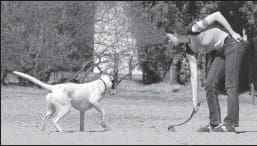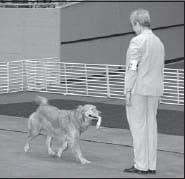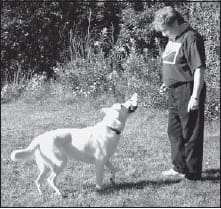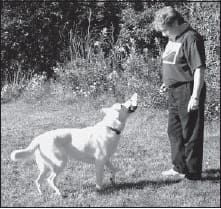Last week a trainer friend stopped by to visit with her three dogs: Star, Kaiya, and Lhotse. As we were chatting, Laura confessed to me that she thought she’d ruined Star’s “fetch” with the clicker. “She had a great retrieve,” Laura said, “until I started clicking her for it. Now she just drops it as soon as I click. I stopped working on it because I knew I was messing it up.” I chuckled to myself. I knew this would be a fun – and easy – training fix. We set to work, and in three short sessions, Star and Laura were well on their way to rehabilitating their great retrieve. There’s a small ceramic plaque sitting on my bookshelf that depicts a spotted dog running with a stick in his mouth, and the inscription, “Born to Fetch.” It’s a constant reminder to me that dogs are very oral creatures. They are, indeed, born to put things in their mouths, as any puppy owner can attest to. When you don’t have hands with opposable thumbs, the next best way to transport objects is with your teeth. So why all the angst about teaching dogs a behavior that comes so naturally to them?

288
For starters, mouth behaviors are one of the first that owners tend to suppress. The majority of the time when a puppy picks something up, he gets yelled at. He learns to restrict his teeth to a small list of legal chew objects, knowing he could be in deep doo-doo for picking up anything not on the list. Sometimes mouth behavior isn’t suppressed by punishment. Instead, a pup may learn that picking something up in his mouth is a nearly foolproof way to get humans to play “chase-me” games, as his owners flail wildly after him trying to rescue valuable or harmful items. He’ll still pick things up, but any inclination to bring them back is long gone. It’s no wonder so many owners tear their hair out and give up when they try to teach their dogs to fetch. They’ve unintentionally taught their dogs to “not-fetch.” The retrieve is such a useful behavior, it’s a darn shame we make it so hard for our canine pals. A dog who retrieves can:
-Be kept easily exercised and amused with long sessions of “Fetch the Ball” in the backyard, or even in the house in inclement weather. Exercise is a great behavior modifier: a tired dog is a well-behaved dog.
-Be taught to find and bring back lost objects.
-Compete in obedience trials and other canine competitions.
-Learn to do other things with his mouth, including open doors, pick up dropped objects, pull wagons, carry groceries, remove items of clothing, and more. Having a dog excited about retrieving also gives you a tool for keeping his attention around distractions, and for getting really sharp recalls and other operant behaviors. A highly valued tennis ball can be a great reinforcer for spiffy recalls and downs, among other behaviors.
Informal v. formal retrieves
There are different types of retrieves. The majority of dog owners are delighted with a dog who dances in anticipation of the ball, chases after it the instant it’s thrown, maybe runs around with it for a bit, then eventually brings it back, and drops it at the owner’s feet. Compare that to the formal show retrieve, where the dog sits motionless in heel position while the owner throws the dumbbell, dashes forward when the owner gives the cue, grabs the dumbbell by the center bar, returns quickly to the owner, and sits in front, perfectly straight, waiting for the cue to release the object carefully into the human’s hands.

288
Even if you’re not interested in a formal retrieve, consider taking advantage of a good game of fetch as an opportunity to reinforce good manners behaviors. Consistently ask your dog to “Sit” before you throw the ball, until he starts offering to sit without being asked. “Sit” makes good things happen! It’s also a deference behavior and a good “self-control” lesson. When he’s good at “Sit for the ball!” try doing the same thing with “Down for the ball!” You can also use a valued fetch toy to install an off-switch for your dog. When it’s time to stop the game, use a cue like “All done!” or “That’s all!” and immediately put the ball where he can’t see it – in a pocket, drawer, or cupboard. Turn and walk away – totally ignoring any attempts on the dog’s part to reengage you in the game. In time, your “All done!” cue will not only serve notice to the dog that the fetch game is over, you’ll also be able to use it to end other behaviors. Whether you’re interested in an informal fetch or a formal retrieve, your task will be easier if you encourage rather than discourage retrieve-related behaviors early in your relationship with your dog. When he has something in his mouth, praise him – tell him he’s a good dog. If it’s something he shouldn’t have, cheerfully trade it for a high-value treat, divert his interest to a “legal” toy, and make a mental note to increase your management efforts to minimize his access to things he shouldn’t fetch. If it’s something he’s allowed to have, sometimes praise and let him be, and sometimes say “Give,” trade for a treat, and give him the toy or chewie back again.
Dogs who are eager to pick things up are the easy ones; it’s just a matter of shaping the retrieve you want, and if you’re going for that formal retrieve, “chaining” or “backchaining” the fetch behavior into the whole show ring retrieve routine (see “The Shape of Things to Come,” March 2006, and “Higher Education,”April 2004). It’s the ones who don’t want to use their mouths who present the biggest challenge. If your dog is not a natural retriever, don’t despair.
Designate his most favorite toy as his fetch object. He only gets to play with it when you do the fetch game. Now set it on the ground; don’t throw it! If he picks it up, click! a clicker (or use another signal or marker, such as the word “Yes!”) and give your dog a delicious treat reward. But if he only sniffs the toy, or even just glances in the object’s direction, click! and reward. In the beginning, the goal is to reinforce him just for paying attention to the object. In any series of “attention” trials with the fetch toy, he may sniff or touch it, just look at it, put his mouth on it, or maybe even pick it up. Once he understands the game you can up the ante (“raise the criteria”); you click! and treat only if he touches the toy. Then, later, you click! and treat only if he actually puts his mouth on it, and finally only if he picks it up. Once he is picking up the toy routinely, add your verbal cue of “Fetch!” (or “Take it!” or “Get it!” or whatever you plan to use). If at any time he “quits” – that is, he stops playing the game – you may have raised the criteria too quickly, or you may have trained for too long.
Training sessions should generally be five to 15 minutes in length, several times a day. If you get two or three really good responses in a row, stop the session with lots of praise and a “jackpot” – a whole handful of treats, one at a time. It’s always better to stop when you and your dog are having fun and winning, rather than when one or both of you are bored or frustrated. While certain breeds are genetically programmed to be more oral than others (Golden Retrievers and Labradors, for starters), virtually any dog can learn to fetch. Although Scottish Terriers are not known for their natural retrieving ability, my little black Dubhy surprised the heck out of me one day. I had been reinforcing the young Terrier for bringing things to me rather than chewing them up, but we hadn’t really worked on retrieving. I was tossing a ball for Tucker, our Cattle Dog-mix, in the backyard, and overestimated the older dog’s endurance. Tucker quit mid-fetch, leaving the tennis ball halfway across the yard. Dubhy, who had been watching from the sidelines, perked up, trotted across the yard, grabbed the ball, trotted back to me, and dropped it neatly at my feet. “So there!” was the only comment I could interpret from his slightly smug expression. And yes, we’ve since put his retrieve on cue, and used his “hold” behavior to teach him “Pups in a blanket,” where he lies down on a blanket, grabs the corner, and rolls over to wrap himself up. Just one more creative application for a good “fetch” behavior.
Shaping success Laura Dorfman, owner of Kona’s Touch, Inc., in Chicago, is a dedicated and talented “crossover” trainer; early in her career, she used force-based techniques. Laura began her crossover journey several years ago, attending conferences and seminars, and reading a long list of books to enhance her positive training knowledge and skills. She currently has three dogs benefiting from her positive-only pursuits: Collie/Lab-mix Star, Terrier-mix Kaiya, and Beagle Lhotse. Like many trainers, while Laura skillfully assists other dog owners with their furry family members’ training and behavior, she sometimes has doubts about her own dogs’ training programs. She brought her pack to me to address several behavior concerns, including Star’s retrieve. “Nothing to be ashamed of,” I assured her. “Even world-class professional athletes, equestrians, and yes, dog trainers, work with coaches to improve their performances. None of us are so good we can’t benefit from another pair of eyes and another perspective.” Here’s how we rehabilitated Star’s lost retrieve:
– First session: 15 minutes We decided our criterion to start would be any attention to a stuffed toy. We placed the toy on the floor. When Star sniffed it, Laura clicked a clicker and gave Star a high-value treat. We kept clicking any time Star looked at or sniffed the toy. After a dozen clicks, Star lifted the toy a few inches off the floor. Laura happily clicked and treated – and then made a common mistake. Because Star lifted the toy once, Laura wanted to immediately increase the difficulty of the desired task to “lift the toy.” Instead, I suggested we put “sniff the toy” on an intermittent schedule of reinforcement, meaning that sometimes Laura would click and treat for sniffing, sometimes not – but she would always click and treat for mouthing or lifting the toy. An intermittent schedule makes a behavior durable, and often elicits a more intense behavior. That is, Star would understand that if she kept trying she would eventually still get clicked, and her frustration at not getting clicked might induce her to mouth or lift the toy more frequently. This is an important step before raising the criteria. If a dog suddenly stops getting clicked for a behavior, she may just quit working, thinking the behavior’s no longer paying off. On the intermittent schedule, Star began putting her mouth on the toy much more frequently. Toward the end of this session we upped the ante again: Laura would click and treat for any mouthing or lifting of the toy, but stopped clicking for just a sniff. We ended the session after several consecutive mouthings, a number of which also included lifts, with some of the lifts to Star’s full height. Good progress!
– Next morning: 15 minutes Laura did not practice with Star between yesterday’s session and this morning. When we started working, Star consistently mouthed the toy, and lifted it off the floor a few inches or more at least 75 percent of the time – working above the level that we ended on the prior day. This illustrates the phenomenon known as “latent learning” – where the dog’s (or other subject’s) brain actually processes information while at rest, and learning can advance as a result. This is why it’s helpful to “end on a good note” – as the brain appears to process most what it absorbed last.

288
We set our initial criterion at “any mouthing,” then put that on an intermittent schedule, and soon after expanded the requirement to “opening mouth wide enough to grasp the whole toy.” By this time Laura had really grasped the concept of shaping, and stopped trying to raise the criteria too quickly. Her clicks were well-timed, and she was making good judgmentsabout which behaviors to click without my nudging. She and Star were both learning! Star proceeded quickly to consistent “wide open mouth behavior,” which we then put on an intermittent schedule before setting the bar at “lifting toy a few inches off the floor.” Of course, as we began to click! and treat Star for “lifting toy a few inches,” more and more frequently Star lifted the toy to full height. Although we had planned for several intermediate increases in the criteria, we realized that Star was going to skip several steps for us. We started putting “lifting the toy a few inches” on an intermittent schedule, and halted the session after several consecutive full-height lifts. By this time Star had come to love her “fetch” toy, and actively sought it when we put it out of her reach, but still in sight. We used her “All done!” cue and put it out of sight.
– Same afternoon: 10 minutes Once again, Star and Laura dove right into the “fetch” exercise. Star became quite enthusiastic about this game, and consistently lifted the toy to full height. We raised the criterion to “full height,” consistently clicking her repeated successful full lifts. Next we introduced time as a criterion, intermittently reinforcing full lifts, but making sure to click all lifts and holds that lasted one second or longer – as opposed to lift/drops or lift/flings. As our last step for this third session, we increased our requirement to one-second holds, no longer clicking for lift/drops or lift/flings, ending with several consecutive successes. Our plan beyond session three was to continue raising the time criterion for the “hold” behavior, and then add movement, as the next criterion. Laura tells me that Star is continuing to make good progress in her fetch rehabilitation program. Both of them are having fun with fetch now, and Laura, more confident with her shaping.
Pat Miller, CPDT, is WDJ’s Training Editor. Miller lives in Hagerstown, Maryland, site of her Peaceable Paws training center.






